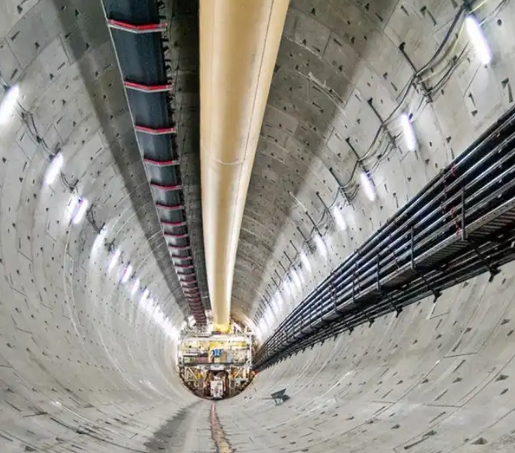The basic methods of tunnel construction mechanical ventilation mainly include air blowing, air exhaust, air supply and exhaust mixed, combined and roadway.
1. Air blowing type
The air-blowing tunnel ventilation duct is located outside the tunnel, and the air outlet is located near the face of the tunnel. Under the action of the fan, fresh air is sent to the face of the tunnel from outside the tunnel through pipelines to dilute pollutants, and polluted air is drained to the outside, and the layout is shown in Figure 1.

2. Air exhaust type
The air exhaust is divided into positive pressure exhaust type and negative pressure exhaust type. The air inlet of the duct is located near the face of the tunnel, and the air outlet is located outside the tunnel. Under the action of the fan, fresh air passes through the tunnel to the face of the tunnel, and vitiated air is directly discharged from the duct to outside. Its layout is shown in Figure 2 and Figure 3.

Figure 2

Figure 3
3. Air blowing and air exhaust mixed type
The air blowing and air exhaust combined type is a combination of blowing air and exhaust air. It has two forms, one is a positive pressure exhaust mixed type, and the other is a negative pressure exhaust mixed type, as shown in Figure 4 and Figure 5.
Under the action of the fan, fresh air enters the tunnel from the outside of the tunnel, flows to the inlet of the blower and enters the blowing air ventilation duct, and reaches the tunnel face through the blowing air ventilation duct, and the vitiated air flows from the tunnel face to the entrance of the exhaust duct from the tunnel face, enter the exhaust duct, and exhaust to the outside of the tunnel through the exhaust duct.

Figure4

Figure5
4. Combination type
The air blowing type and exhaust type are used at the same time to form a combination type. Similarly, there are two types of combination use, positive pressure exhaust combination use and negative pressure exhaust combination use.
Part of the fresh air is sent to the face of the tunnel through the blowing air ventilation duct, part of the fresh air enters the tunnel through the tunnel from the outside of the tunnel, part of the vitiated air flows from the face of the tunnel to the entrance of the exhaust pipe, and the other part of the fresh air from the tunnel dilutes pollutants along the way. After the vitiated air flows to the inlet of the exhaust pipe, the two vitiated air flows into the exhaust pipe and discharged outside the tunnel. The arrangement is shown in Figure 6 and Figure 7.

Figure 6

Figure7
5. Roadway type
The roadway type is divided into the jet roadway type and the main fan roadway type.
Jet tunnel type is under the action of jet fan, fresh air enters from one tunnel through the tunnel wind tunnel, vitiated air is discharged from another tunnel, and fresh air reaches the face of the tunnel through the blowing air ventilation duct. The layout is shown in Figure 8.

Figure8
The main fan tunnel type is under the action of the main fan, the fresh air enters from one tunnel, the vitiated air is discharged from another tunnel, and the fresh air is distributed to the face of the tunnel by the tunnel ventilation duct. The layout is shown in Figure 9.

Figure9
To ensure the underground construction in safety, we has already produced more environmental friendly and lower air leakage rate PVC Ventilation Ducts. This kind of ventilation ducts are light weight to reduce the labor costs, but also have the advantages of strong compressive and easy installation, and there are resistance against flame, anti-static, cold, UV-light, etc.








